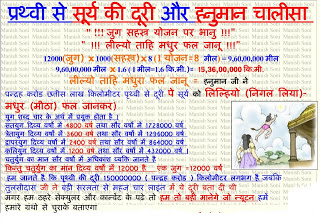सनातन धर्म की विश्व् को देंन
प्रकाश की गति : ऋग्वेद में मोजूद हे | Speed of light in Rigveda
माना जाता है की आधुनिक काल में प्रकाश की गति की गणना Scotland के एक भोतिक विज्ञानी James Clerk Maxwell (13 June 1831 – 5 November 1879) ने की थी ।
जबकि आधुनिक समय में महर्षि सायण , जो वेदों के महान भाष्यकार थे , ने १४वीं सदी में प्रकाश की गति की गणना कर डाली थी जिसका आधार ऋग्वेद के प्रथम मंडल के ५ ० वें सूक्त का चोथा श्लोक था ।
तरणिर्विश्वदर्शतो ज्योतिष्कृदसि सूर्य ।
विश्वमा भासि रोचनम् ॥ ...ऋग्वेद १. ५ ० .४
विश्वमा भासि रोचनम् ॥ ...ऋग्वेद १. ५ ० .४
अर्थात् हे सूर्य, तुम तीव्रगामी एवं सर्वसुन्दर तथा प्रकाश के दाता और जगत् को प्रकाशित करने वाले हो।
Swift and all beautiful art thou, O Surya (Surya=Sun), maker of the light, Illuming all the radiant realm.
उपरोक्त श्लोक पर टिप्पणी/भाष्य करते हुए महर्षि सायण ने निम्न श्लोक प्रस्तुत किया
तथा च स्मर्यते योजनानां सहस्त्रं द्वे द्वे शते द्वे च योजने एकेन निमिषार्धेन क्रममाण नमोऽस्तुते॥
-सायण ऋग्वेद भाष्य १. ५ ० .४
-सायण ऋग्वेद भाष्य १. ५ ० .४
अर्थात् आधे निमेष में 2202 योजन का मार्गक्रमण करने वाले प्रकाश तुम्हें नमस्कार है
[O light,] bow to you, you who traverse 2,202 yojanas in half a nimesha..
-Sage Sayana 14th AD
-Sage Sayana 14th AD
yojana and nimesha are ancient unit of distance and time respectively.
उपरोक्त श्लोक से हमें प्रकाश के आधे निमिष में 2202 योजन चलने का पता चलता है अब समय की ईकाई निमिष तथा दुरी की ईकाई योजन को आधुनिक ईकाईयों में परिवर्तित कर सकते है ।
किन्तु उससे पूर्व प्राचीन समय व् दुरी की इन ईकाईयों के मान जानने होंगे .
निमेषे दश चाष्टौ च काष्ठा त्रिंशत्तु ताः कलाः |
त्रिंशत्कला मुहूर्तः स्यात् अहोरात्रं तु तावतः || ........मनुस्मृति 1-64
मनुस्मृति 1-64 के अनुसार :
पलक झपकने के समय को 1 निमिष कहा जाता है !
18 निमीष = 1 काष्ठ;
30 काष्ठ = 1 कला;
30 कला = 1 मुहूर्त;
30 मुहूर्त = 1 दिन व् रात (लगभग 24 घंटे )
30 काष्ठ = 1 कला;
30 कला = 1 मुहूर्त;
30 मुहूर्त = 1 दिन व् रात (लगभग 24 घंटे )
As per Manusmriti 1/64 18 nimisha equals 1 kashta, 30 kashta equals 1 kala, 30 kala equals 1 muhurta, 30 muhurta equals 1 day+night
अतः एक दिन (24 घंटे) में निमिष हुए :
24 घंटे = 30*30*30*18= 486000 निमिष
hence, in 24 hours there are 486000 nimishas.
24 घंटे में सेकंड हुए = 24*60*60 = 86400 सेकंड
86400 सेकंड =486000 निमिष
अतः 1 सेकंड में निमिष हुए :
1 निमिष = 86400 /486000 = .17778 सेकंड
1/2 निमिष =.08889 सेकंड
in 1/2 nimisha approx .08889 seconds
अब योजन ज्ञान करना है , श्रीमद्भागवतम 3.30.24, 5.1.33, 5.20.43 आदि के अनुसार
1 योजन = 8 मील लगभग
2202 योजन = 8 * 2202 = 17616 मील
As per Shrimadbhagwatam 1 yojana equals to approx 8 miles.
सूर्य प्रकाश 1/2 (आधे) निमिष में 2202 योजन चलता है अर्थात
.08889 सेकंड में 17616 मील चलता है ।
.08889 सेकंड में प्रकाश की गति = 17616 मील
1 सेक में = 17616 / .08889 = 198177 मील लगभग
Speed of light in vedas 198177 miles per second approximately .
आज की प्रकाश गति गणना 186000 मील प्रति सेकंड लगभग
In morden science , its 186000 miles per second approximately.









